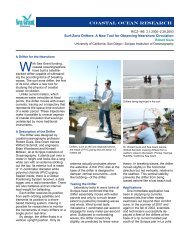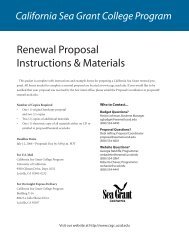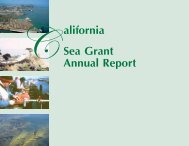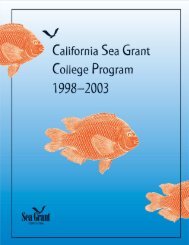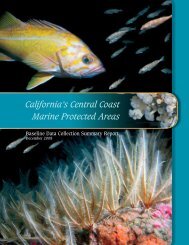Crescent City Profile - California Sea Grant
Crescent City Profile - California Sea Grant
Crescent City Profile - California Sea Grant
- No tags were found...
You also want an ePaper? Increase the reach of your titles
YUMPU automatically turns print PDFs into web optimized ePapers that Google loves.
The Harbor DistrictAs fishing activity has declined over the last30 years, so has the harbor’s revenue base.Revenue sources include income from sliprentals and related services, fees for offloadingcommercially-caught fish and ice and fuelsales, and rent from other concessions (RRMDesign Group 2006). In addition, the harbordistrict receives County property taxes(although these have been appropriated in partby the state in recent years) and various loansand grants from federal and state governmentagencies. At the same time, operating costshave become significant, particularly withrespect to dredging the harbor channelsand removing tailings, and maintaining andoperating the wastewater treatment plant,which is required for fish processing. Inaddition, according to Harbormaster RichardYoung, historically the harbor district madelittle or no provision for basic maintenanceand repair of the docks or their replacement.As a result, these costs have grown. Harborfacilities also need to be brought up to code tomeet Americans with Disabilities Act and otherrequirements, which add to their cost (RRMDesign Group 2006, Madar 2009a).DredgingAs with most <strong>California</strong> harbors, access intoand out of <strong>Crescent</strong> <strong>City</strong> Harbor depends onmaintenance dredging of its navigable channelsand boat basins. The biggest obstacle to dredgingthe harbor has been adequate funding, for boththe removal of dredged materials (spoils ortailings) and their disposal. The estimated costto dredge the federal channel and the inner boatbasin is $2–$3 million. Like most other harborsin <strong>California</strong>, <strong>Crescent</strong> <strong>City</strong> Harbor depends onCongressional appropriations to allocate funds tothe Army Corps of Engineers for the work.Over the past decade, the harbor has beendredged irregularly, once in 2000 and again in2009 after conditions became critical. Portionsof the federal navigation channel had depths asshallow as two feet, where they are supposedto be at least 15 feet deep (Madar 2009b). As aresult, most vessels had to wait for high tide toenter or leave the harbor, creating safety issues aswell as economic costs.A second obstacle has been securing a site forthe disposal of dredged materials. For manyyears, <strong>Crescent</strong> <strong>City</strong> Harbor had access to anoffshore disposal site. Following the closureof that site, the tailings were dried at its 5.3-acre dewatering site, then transported to theDel Norte County landfill. With the dewateringponds full and the landfill closed to newmaterials, finding a cost-effective disposal sitehas posed a significant challenge. Recently,however, about three acres of Del Norte SolidWaste Management Authority excavationareas have been suggested as a possible dredgematerials disposal site (Madar 2009c).The November 2006 tsunami exacerbatedshoaling and damaged the inner boat basin,especially G- and H-docks, where 35 slipswere lost (Ma 2008). Although the initialassessment estimated repair costs at about$5 million, subsequent investigations haveestimated that as much as $25.4 million may beneeded to repair the tsunami damage and bringthe inner boat basin up to code (Ma 2008).State and federal funds may be available for upto 75% of the cost, with local (harbor, city and/or county) funds required for the remainder.In June 2009, the harbor received a $5 millionCommunity Development Block <strong>Grant</strong> for thematch (Madar 2009a). 33Wastewater Treatment PlantIn 1992, <strong>Crescent</strong> <strong>City</strong> was awarded a federalgrant to build a wastewater treatment plant,with the goal of accommodating up to fiveprocessing plants or 800,000 gallons of waterper day. When the plant went online in 1993,three fish processing plants used it to pretreatwaste from their operations, especially thosefor shrimp and groundfish. Due to a design<strong>Crescent</strong> <strong>City</strong> Fishing Community <strong>Profile</strong> 48



